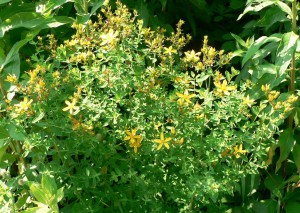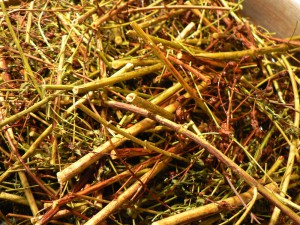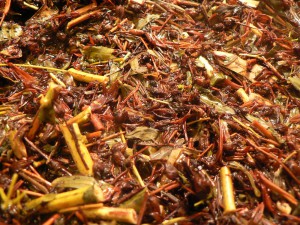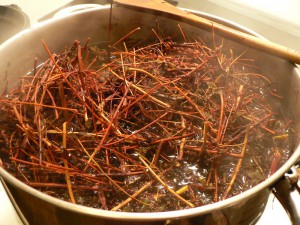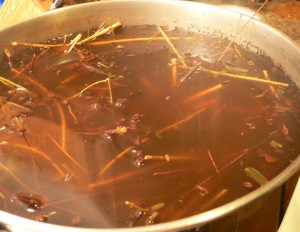This weekend, May 24th and 25th, is the 40th annual Massachusetts Sheep and Woolcraft Fair at the Cummington Fairgrounds. I am doing natural dyeing demonstrations again this year. I was there from 2-4 yesterday and will be there from 1-3 today. Yesterday’s weather was lovely for most of the day and I had a large crowd. Thanks to everyone who stopped by to watch and listen and ask questions! We had a brief heavy afternoon rainstorm but it cleared up after about half an hour. Today is supposed to be warmer with a slight chance of heavy rain and hail. Well, let’s hope for the best.
To prepare for the demo, on Friday night I made a dyebath with 12 ounces of dried whole tops of St.-John’s-wort from last fall. I cut the tops back after the flowers had gone by, and the dried stems and leaves had turned an amazing red color. I’ve used St.-John’s-wort flowers before, and the whole tops in bloom, but never just the dried tops alone. So, it is an experiment.
Here’s what St.-John’s-wort looks like in bloom.
It is a lovely plant, introduced from Europe I believe, and naturalized here in the Northeast. It’s a hardy perennial and it’s very vigorous when it gets established. To be honest, when I put it in my dyeplant garden I didn’t expect it to spread so readily, so I have had to dig up some of it each spring. I’m not complaining, though. It’s nice to have a plant you don’t have to fuss over or worry about.
Here’s the dyebath in process. First, the chopped up stems as they are getting wet in the pot:
Here’s the plant matter after it soaked for a while and the dried leaves absorbed some moisture again. You can see the reddish color I was so excited about.
Here are the stems again after heating for about half an hour, and then below that, the dyebath once it’s been heating for an hour.
I let the plant material cool and soak in the dyebath overnight. At the demo yesterday when I strained it out, the liquid was a murky gold.
For the demo I’m using 4 ounce skeins of a nice 4-ply wool mill end from Webs pre-mordanted with aluminum sulfate. After the yarn had been soaking on a low-to-medium heat for a couple hours, the yarn had become a medium brown. I was hoping for something with a pink, rosy, or orange quality, but it’s nice enough.
In her book A Dyer’s Garden, Rita Buchanan encourages every dyer to try St.-John’s-wort flowers because you can get a wide range of different colors as you exhaust the bath. She suggests making a strong dyebath with the flowers, then dyeing your first skein with alum-mordanted wool for just 10 to 15 minutes. This will give a green color. Then add an unmordanted skein of wool to the same dyebath and simmer for an hour for a mauve-red. Then, add a third alum-mordanted skein to the cooling bath and soak overnight for a gray or brown shade. Then the next day, reheat the bath with an alum-mordanted skein for gold or tan. I tried this once and I did get approximately the shade she describes.
However, for this experiment with the whole dried tops I didn’t follow her sequence. The alum-mordanted yarn sat and heated for the duration of the workshop and then I left it in the dyebath overnight. Today I plan to exhaust the bath with another 4 ounce alum-mordanted skein of wool. Chances are we’ll just get a beige or tan, but it could be that the color will shift significantly. You never know until you try.

